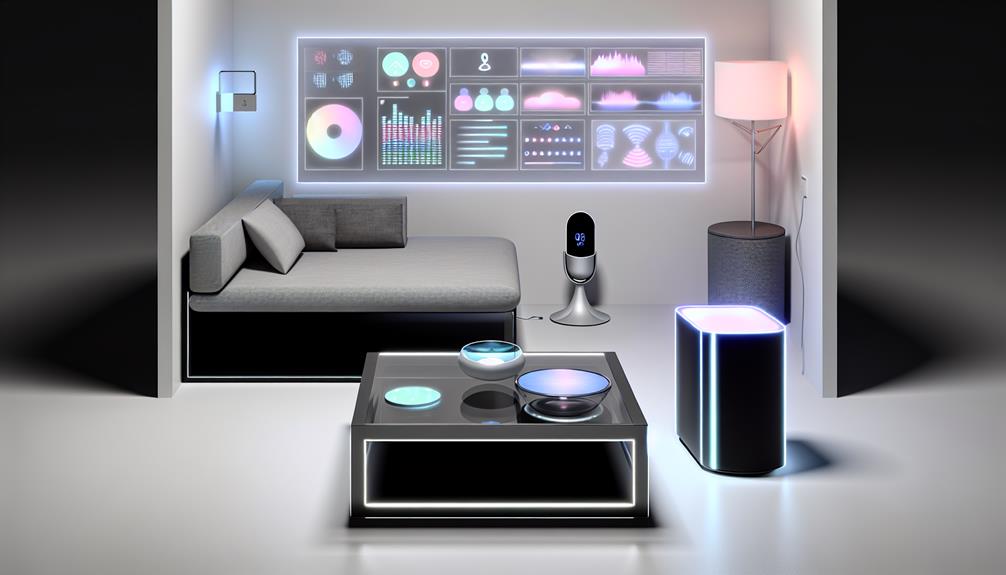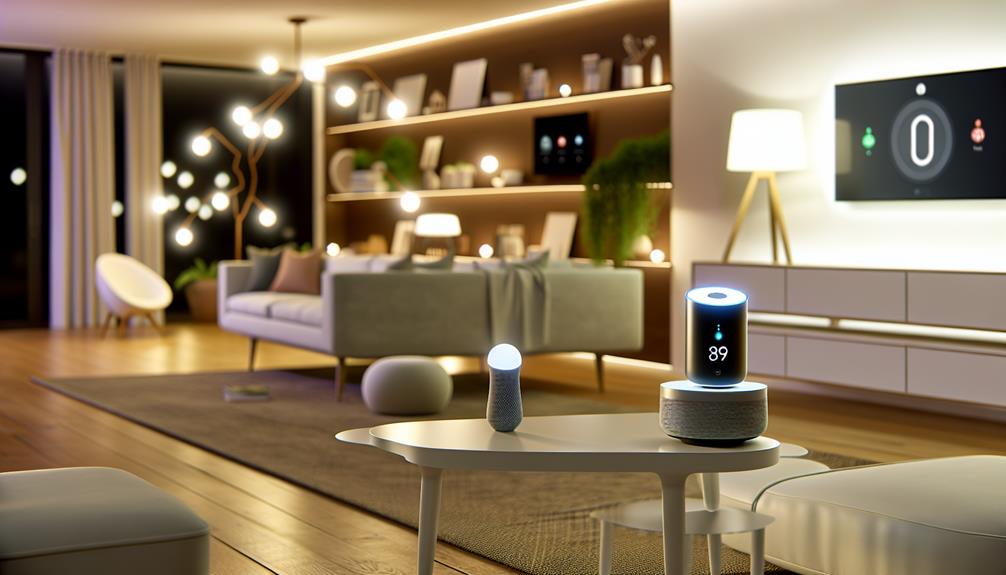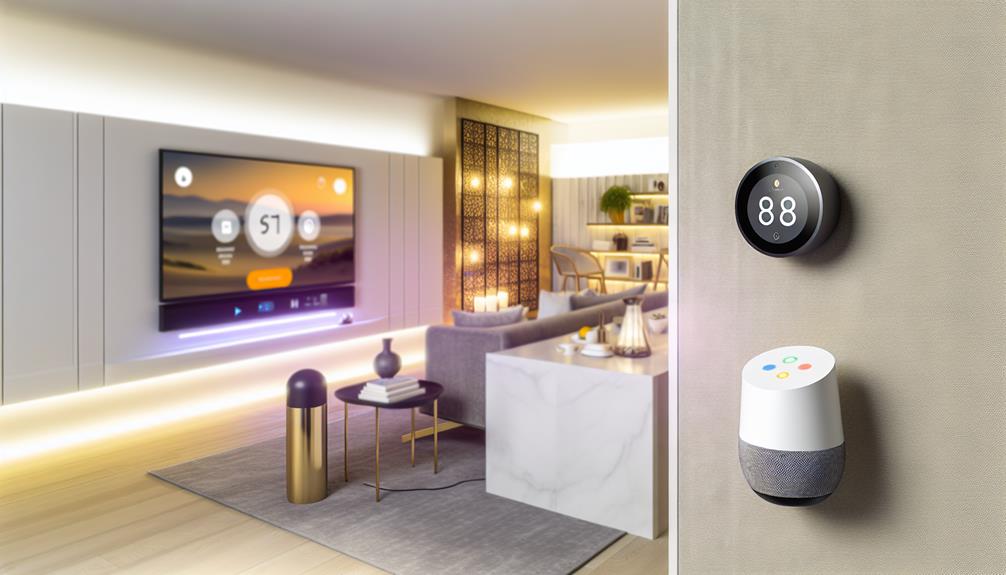Are Smart Homes Really Getting Smarter With AI?
The integration of artificial intelligence into smart home technologies has unquestionably transformed user experiences, presenting a new era of convenience and efficiency. AI's capabilities in automating tasks, optimizing energy use, and enhancing security systems suggest a significant leap in how we interact with our living environments. However, as these advancements unfold, critical questions arise regarding privacy implications and the interoperability of devices. What does this mean for the future of smart homes, and can we truly trust these systems to act in our best interests? The answers may redefine our understanding of home automation.
Key takeaways
- AI optimizes energy consumption in smart homes, enabling real-time adjustments for cost savings and efficient resource use.
- Personalized user experiences are enhanced through adaptive learning algorithms, creating unique profiles for each household member.
- Predictive maintenance solutions alert homeowners to potential issues, preventing costly breakdowns and ensuring seamless operation of devices.
- Voice assistants improve user interaction by enabling hands-free control, making smart home technology more accessible to diverse demographics.
- Enhanced security features powered by AI, such as anomaly detection and remote monitoring, provide robust protection for smart home systems.
Evolution of Smart Homes
Over the past few decades, the evolution of smart homes has been marked by remarkable advancements in technology, transforming the way we interact with our living spaces. As smart technology continues to gain traction, user adoption has surged, fueled by shifting market trends and increasing consumer demand for enhanced convenience and efficiency.
Design innovations in smart devices have made them more aesthetically pleasing and easier to integrate into diverse home environments, fostering a sense of belonging and personal style.
Connectivity advancements have played a vital role in this home evolution, allowing devices to communicate seamlessly and creating a cohesive ecosystem. As tech convergence becomes more prevalent, the integration of various technologies into single platforms enhances usability improvements, making smart homes more accessible for all users.
This lifestyle integration is not merely about automation; it's about enriching daily experiences and promoting a greater sense of security and comfort. As we look ahead, the ongoing development of smart homes will continue to reflect the changing needs and aspirations of society, paving the way for a future where technology harmoniously supports our everyday lives.
Role of AI in Automation
Artificial Intelligence plays a pivotal role in the automation of smart homes, notably enhancing energy management through intelligent consumption patterns.
By analyzing user behaviors, AI can create personalized experiences that adapt to individual preferences, ultimately increasing convenience and satisfaction.
Additionally, predictive maintenance solutions powered by AI can foresee potential issues, prompting timely interventions that reduce costs and extend the lifespan of home systems.
Enhanced Energy Management
Efficiency is paramount in modern energy management, and the integration of AI in smart homes considerably enhances this aspect through automation. By leveraging AI technologies, smart homes can optimize energy consumption in real-time, ensuring that resources are used effectively without compromising comfort. Through machine learning algorithms, these systems analyze usage patterns and adjust energy settings accordingly, resulting in significant savings and reduced environmental impact.
Moreover, AI facilitates seamless communication with the smart grid, allowing homeowners to take advantage of dynamic pricing models. When energy demand is low, AI can automatically shift high-consumption activities, such as running appliances, to off-peak hours. This not only lowers utility bills but also contributes to a more sustainable energy ecosystem.
As smart homes become more connected, the role of AI in energy management grows increasingly essential. Homeowners can effortlessly monitor, control, and optimize their energy consumption through user-friendly interfaces, creating a sense of community among those committed to energy efficiency.
Ultimately, the advanced automation offered by AI fosters a collective responsibility toward sustainable living, empowering individuals to make meaningful contributions to our planet's well-being.
Personalized User Experiences
In today's fast-paced world, the integration of AI in smart homes transforms the way we interact with our living environments, creating highly personalized user experiences. By leveraging adaptive learning algorithms, smart home systems can analyze user preferences and behavior patterns to develop unique profiles for each household member. This contextual awareness allows for customized interfaces that respond intuitively to individual needs.
| Feature | Description | Benefit |
|---|---|---|
| Customized Interfaces | User-friendly dashboards tailored to preferences | Simplifies interaction |
| Intelligent Suggestions | Real-time advice based on behavior trends | Enhances daily convenience |
| Tailored Recommendations | Personalized content and service suggestions | Increases user satisfaction |
These intelligent suggestions foster a sense of belonging, as smart homes become attuned to individual lifestyles. By offering tailored recommendations, homeowners can enjoy a seamless blend of technology and comfort. The capacity for AI to evolve through continuous adaptive learning guarantees that the smart home experience remains relevant and engaging, ultimately creating a living space that feels uniquely theirs.
Predictive Maintenance Solutions
As smart homes become increasingly sophisticated, the role of AI extends beyond personalized user experiences to encompass predictive maintenance solutions. By leveraging advancements in sensor technology, AI systems can monitor the performance of various home components, providing intelligent insights that enhance overall efficiency.
These predictive maintenance solutions offer several benefits:
- Maintenance Alerts: Automated notifications inform homeowners of potential issues before they escalate, allowing for timely interventions.
- Performance Monitoring: Continuous analysis of appliance and system performance guarantees that everything functions efficiently, preventing costly breakdowns.
- Cost Savings: By addressing problems proactively, homeowners can avoid expensive repairs and prolong the lifespan of their systems.
- User Education: AI-driven insights can empower users with knowledge on effective usage patterns and necessary system updates, enhancing their connection to their home technology.
As hardware advancements continue to evolve, service providers can integrate these predictive capabilities, fostering a sense of community and belonging among users who benefit from smarter living environments.
Ultimately, predictive maintenance not only enhances home management but also transforms the way residents interact with their living spaces, creating a seamless blend of technology and comfort.
Predictive Analytics in Home Management
Harnessing the power of predictive analytics in home management transforms the way homeowners interact with their living environments. By leveraging data forecasting techniques, smart home systems can analyze user behavior patterns to anticipate needs and optimize daily routines. This proactive approach not only enhances convenience but also promotes energy efficiency and cost savings.
For instance, predictive analytics can enable smart thermostats to learn the occupants' schedules and preferences, adjusting temperatures automatically to guarantee comfort while minimizing energy consumption. Similarly, smart lighting systems can adapt to changing daylight conditions and occupancy patterns, guaranteeing that spaces are well-lit when needed and conserving energy when they are not.
Moreover, these intelligent systems create a sense of belonging by personalizing the home environment to reflect the unique lifestyles of its inhabitants. As homeowners gain insights into their habits and preferences, they can make informed choices that align with their values, such as reducing waste or enhancing well-being.
In essence, predictive analytics in home management signifies a shift towards a more intuitive, responsive living experience, where technology not only serves but also understands the needs of those it supports.
Voice Assistants and User Interaction
The integration of voice assistants into smart home ecosystems represents a significant evolution in user interaction, building on the capabilities established by predictive analytics. Voice recognition technology empowers users to communicate seamlessly with their devices, fostering a more intuitive experience.
However, this interaction is not without its complexities, as it necessitates a balance between convenience and privacy concerns.
To enhance user trust and satisfaction, developers must prioritize several key areas:
- User Feedback: Continuous input from users can help refine voice recognition accuracy and responsiveness.
- Conversational Context: Understanding the context of user commands improves the relevance of responses, making interactions feel more natural.
- Accessibility Options: Tailoring features for individuals with diverse needs guarantees inclusivity and broadens user engagement.
- Multilingual Support: Offering multiple languages caters to a diverse audience, enabling wider adoption of smart home technology.
Incorporating emotional intelligence into voice assistants can further personalize interactions, reflecting users' customization preferences and interaction frequency.
As smart homes become increasingly sophisticated, the emphasis on user-centric design will be essential for fostering belonging and enhancing the overall experience.
Integration of IoT Devices
The integration of IoT devices is essential for achieving seamless communication among smart home technologies, allowing them to work in harmony.
This interconnectedness not only enhances automation capabilities but also provides data-driven insights that enable users to optimize their living environments.
As smart homes evolve, understanding the dynamics of IoT integration will be vital for maximizing their potential and improving user experiences.
Seamless Device Communication
In an era where convenience and efficiency are paramount, seamless device communication stands as a cornerstone of smart home technology, facilitating the integration of various Internet of Things (IoT) devices. This integration relies on interoperable systems that guarantee compatibility among diverse devices, fostering a user-friendly experience.
Key components of seamless device communication include:
- Protocol Standardization: Establishing common communication protocols enhances device compatibility, allowing different brands and types of devices to work together harmoniously.
- Data Synchronization: Confirming that data across devices is consistently updated promotes a cohesive user interface, ultimately improving the overall smart home experience.
- Remote Access: Users can control their devices from anywhere, providing convenience and peace of mind, especially when combined with cloud integration.
- Network Security: Protecting communication channels is vital, as it safeguards user data and enhances trust in smart home technology.
Enhanced Automation Capabilities
Enhanced automation capabilities represent a significant evolution in the integration of IoT devices within smart homes. These advancements enable homeowners to experience seamless interactions with their living environments, transforming daily routines into more efficient, enjoyable processes.
With smart scheduling and adaptive routines, devices can learn user preferences and automatically adjust settings, ensuring that each moment aligns with individual lifestyles. Automated security features provide peace of mind, offering remote accessibility to monitor and control home safety measures.
Intuitive controls and user-friendly interfaces further enhance the overall experience, making technology approachable for all family members. Context-aware systems can anticipate needs, allowing for dynamic adjustments that create responsive environments tailored to specific times of day or activities.
The integration of these technologies fosters a sense of belonging, as families can enjoy the comfort of a home that adapts to their needs. As smart homes continue to evolve, the emphasis on enhanced automation capabilities will not only redefine convenience but also enrich the everyday experiences of those who inhabit them.
This shift towards a more interconnected lifestyle showcases the potential of IoT devices to create truly intelligent living spaces that resonate with the modern homeowner's aspirations.
Data-Driven Insights
Smart homes not only offer enhanced automation capabilities but also generate a wealth of data that can be harnessed for deeper insights into user behavior and preferences. This data-driven approach can greatly improve the user experience, yet it raises crucial concerns regarding ethical considerations and data privacy.
To navigate this complex landscape, it is important to focus on key aspects of data usage in smart homes:
- User Consent: Ensuring users are aware of what data is collected and how it is used fosters trust.
- Data Ownership: Users should maintain control over their data, deciding who can access it.
- Algorithm Transparency: Clear communication about how algorithms analyze data can help demystify the process.
- Bias Mitigation: Implementing strategies to reduce bias in data interpretation enhances service reliability and user satisfaction.
Moreover, data interoperability among IoT devices can promote seamless integration, allowing for smarter decision-making.
As we embrace these innovations, addressing data privacy concerns and encouraging responsible usage will create a smarter home environment that respects user rights and fosters a sense of belonging within the community.
Security Enhancements With AI
The integration of artificial intelligence into home security systems has revolutionized the way homeowners protect their property and loved ones. Advanced features such as intrusion detection and facial recognition greatly enhance security measures, allowing for more effective monitoring of potential threats.
AI-powered systems can analyze behavioral patterns, enabling anomaly detection that alerts homeowners to unusual activities in real time. Remote monitoring capabilities empower users to oversee their homes from anywhere, providing peace of mind while traveling or at work.
The incorporation of threat intelligence further strengthens access control, ensuring that only authorized individuals can enter the premises. However, these advancements raise important privacy concerns; therefore, robust data encryption practices are essential to safeguarding personal information.
As AI continues to evolve, homeowners can expect even more sophisticated security solutions that not only fortify their properties but also foster a sense of community belonging. By embracing these security enhancements, individuals are not merely investing in technology; they are creating a safer environment for themselves and their families.
Ultimately, the marriage of AI and home security represents a pivotal step towards a more secure and connected living experience.
Energy Efficiency Innovations
As homeowners increasingly prioritize security through AI-driven systems, the potential for energy efficiency innovations in smart homes is becoming more apparent.
These advancements not only enhance convenience but also promote sustainability practices that resonate with environmentally conscious consumers.
Key innovations include:
- Smart Thermostats: These devices learn user preferences to optimize heating and cooling, greatly reducing energy consumption.
- Energy Monitoring: Real-time consumption analysis allows homeowners to understand energy use patterns, enabling informed decisions to minimize waste.
- Solar Integration: Combining solar panels with energy storage solutions enhances grid connectivity and empowers households to produce and store their own energy.
- Demand Response and HVAC Optimization: These systems adjust energy usage based on grid demands, helping to stabilize the grid while lowering costs.
Personalized User Experiences
In today's rapidly evolving technological landscape, personalized user experiences have become a cornerstone of smart home systems, driven largely by artificial intelligence. As homeowners increasingly seek environments that cater to their unique lifestyles, smart devices leverage user preferences to create tailored interactions. Adaptive interfaces analyze behavioral patterns, allowing systems to make dynamic adjustments that enhance daily routines.
Contextual awareness plays a crucial role in this personalization. By understanding the nuances of each user's environment—such as time of day and current activities—smart home systems can offer intelligent recommendations that align with individual needs. For instance, a smart thermostat can adjust temperatures based on user feedback about comfort levels, ensuring an ideal atmosphere at all times.
Moreover, personalized settings enable users to curate their experiences further, from lighting preferences to media selections. This interconnectedness fosters a sense of belonging, as users feel that their homes genuinely reflect their identities.
As technology continues to advance, the integration of AI within smart homes promises to deepen this personalization, driving enhanced user satisfaction and engagement. Ultimately, the future of smart living lies in the ability of systems to understand and adapt to the unique rhythms of each household.
Future Challenges and Considerations
While the promise of smart homes and AI integration is compelling, several future challenges and considerations must be addressed to secure their successful implementation. These challenges can hinder user trust and the overall acceptance of technology in everyday life.
- Privacy Concerns: Personal data collected by smart devices raises questions about security and how this information is utilized, potentially undermining user trust.
- Ethical Implications: The use of AI in decision-making processes can lead to biases, necessitating a thorough evaluation of ethical standards in technology development.
- Interoperability Standards: The lack of uniform standards can create compatibility issues among devices, affecting technology accessibility and diminishing user experience.
- Regulatory Challenges: As smart homes evolve, regulatory frameworks need to adapt, addressing data ownership and environmental impact to secure sustainable practices.
Navigating these challenges will require collaboration between manufacturers, policymakers, and consumers to foster a smart home ecosystem that prioritizes user trust, ethical implications, and accessibility.
Frequently Asked Questions
How Much Does It Cost to Set up a Smart Home?
Setting up a smart home involves careful smart home budgeting. Installation costs vary considerably based on preferred devices and complexity, ranging from a few hundred to several thousand dollars, depending on the desired technology integration and customization.
Can Smart Homes Operate Without Internet Connectivity?
Can smart homes function effectively without internet connectivity? Yes, through offline automation and local control, devices can operate independently, enhancing reliability and security, while ensuring a seamless user experience even in the absence of online access.
What Are the Best Smart Home Devices for Beginners?
For beginners in smart home technology, essential devices include smart lighting systems for customizable ambiance and voice assistants to facilitate seamless control. These foundational tools enhance convenience, creating an inviting environment that fosters a sense of belonging.
Are There Privacy Concerns With Smart Home Technology?
As smart homes weave themselves into our daily lives, privacy concerns arise, encompassing data security, user consent, and device vulnerabilities. The shadows of surveillance risks and ethical implications challenge our understanding of data ownership in this evolving landscape.
How Can I Troubleshoot Common Smart Home Issues?
To troubleshoot common smart home issues, verify device compatibility, reset devices, and check network connections. Utilize troubleshooting tips from manufacturer websites and user forums, as community support fosters a sense of belonging and shared knowledge.



